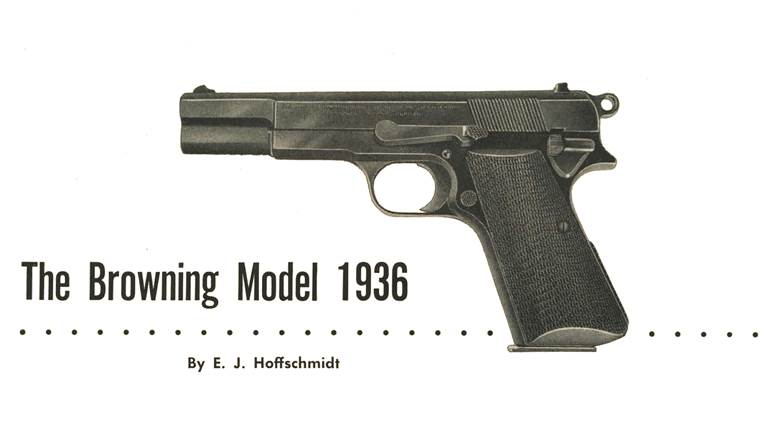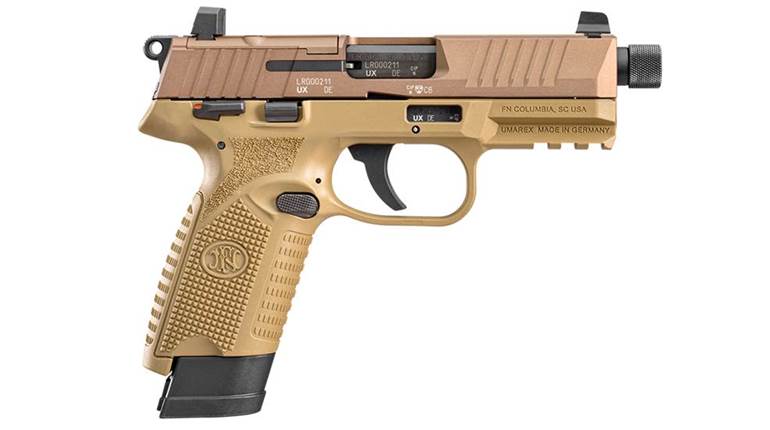
"Chocolate, lace and guns,” are the items people most associate with Belgium. At one time, Belgium was a major economic manufacturing and export country, but long gone are the days in which Belgian Cockerill steam locomotives powered trains all over the globe, or when Dutch bridge builders used Belgian steel, when Belgian textiles were second to none and when Belgian rugs adorned palaces worldwide.
It is with such expansionist business principles that Fabrique Nationale (FN) was created in 1889, and the mentality to capitalize on business and the quality of its materials and craftsmanship remained strong from the Industrial Revolution through the 1960s. It is with that mindset that FN embarked upon the long process of creating the High Power pistol.
Development started in the 1920s with a French government request for a new military pistol. John Browning’s protégé at FN, Dieudonné Saive, was put in charge of the project, and he modified a Model 1903 pistol to accept a double-stack magazine. The model was sent to John Browning, who developed two prototypes from 1921 to 1922. Those two prototypes represent the entirety of Browning’s involvement in the project.
The French trials dragged on for years with frequent changes in requirements. In 1928, FN concluded that the company had already invested too many resources in dealing with the French, and so decided to take the pistol to market. The new military pistol was christened the Grand Rendement (High Efficiency).
The stock market crash of 1929 put an immediate halt to the release of the Baby Browning and High Efficiency models. While the French trials continued, FN demonstrated the pistol to the Belgian military in 1931. The Belgian government was impressed and ordered 1,000 pistols for field trials.
Pre-production started, and FN made about 1,100 pistols that were used for the Belgian trials and marketing. Once the field trials were announced, FN already had the sales pitch it needed; Belgian military equipment had an impeccable reputation for quality.
Pistols were demonstrated worldwide, and some nations still make reference to the model under various names such as Pistola Gran Rendimiento modelo 1933 or 1934. The dates refer to the year the pistol was first evaluated. Decades later, unaware of the early High Efficiency nomenclature, collectors gave these pistols the incorrect designation of “Oval Port High Power.”
The 1933 Belgian field trials were utilized to consolidate options, features and accessories. All trial pistols were supplied with tangent sights, and most were slotted to accept shoulder stocks. The only significant design recommendation was a change to the ejection port from an ovalular to a rectangular shape. It has been speculated that there may have been issues with ejection.
Fabrique Nationale supplied several different shoulder stock options, and the Belgian military adopted the slotted frame with a wooden, flat-board shoulder stock without an attached holster. A separate combination holster—housing the pistol and shoulder stock—was accepted instead. Belgium was the only nation to adopt the flat, wooden-board stock without attached holster. Other nations opted for the standard FN offering, which was the stock with attached holster.
The ejection port changes were implemented, and FN started production after receiving an order for 10,000 pistols, the first of which were completed in March 1935. For marketing reasons, the model was renamed Grande Puissance (High Power), often called G.P. or Model of 1935, after the Belgian military designations. Renaming the model was important, as FN wanted to capitalize on the improved design adopted by the Belgian government.
An interesting side note, from the onset of the trials through 1938, the Belgian military also ordered fully functional training pistols. These were factory marked “Pistolet de Manipulation” (Handling Pistol) and painted red over a phosphate base. Less than 140 High Efficiency and High Power training pistols were ordered. These were used in classrooms and were not intended for firing. The applied red paint was not oil-resistant and dissolved when exposed to gun oil.

Supplying the Belgian troops and non-commissioned officers was the top priority, and they were issued the slotted tangent High Power with flat-board stock, combination holster and a double magazine pouch. Existing FN Model 1900, 1910 and Colt Model 1903 pistols were then gradually phased out.
Commissioned officers had to wait, as they were allowed to wear a sidearm only on maneuvers or in times of war. The first significant replacements for commissioned officers were supplied in 1939, and they were issued the High Power without shoulder stock or combination holster. The pistols were slotted, and incorporated a change in gradation of the sights.
Since 1936, FN made two variants of its 500-meter tangent sights: The original variant for use with the shoulder stock, and a second variant for use without it. The effectiveness of these sights can be debated, but they are, nonetheless, distinguishing features as they reveal if a pistol was factory-issued with a shoulder stock or not.
Fabrique Nationale supplied the Belgian military annually with High Powers. In fact, FN was producing such a contract when Germany invaded in May 1940. The Germans seized pistols on the factory floor, in warehouses and in military arsenals. Belgium’s 18-day struggle to resist the Germans ended with the unconditional surrender of King Leopold III on May 28, 1940. The king’s surrender was considered an act of treason. The Belgian army laid its arms down, and thousands of High Powers were surrendered.
The quality of Belgian armament was highly revered by the Germans. Pistols were reissued almost immediately, including captured training pistols, and they were used in every subsequent German offensive. In fact, almost all of the pre-war Belgian contract pistols encountered in the United States were brought back by servicemen at war’s end.
Fabrique Nationale was sequestered during the occupation and made thousands of FN Model 1922 and High Power pistols for the German military. As the years went by, resistance activity grew, and many pistols were smuggled out of the factory.
Material shortages and the rapid Allied advance brought an end to production at FN in August 1944. The last of the Germans and their collaborators departed the factory on Sept. 5, 1944, just days before liberation. Filled with uncertainty and fearing that the Germans would return, FN workers restarted production with hopes of supplying free Belgian forces and resistance fighters. Those pistols did not go to Belgian forces as anticipated, but instead were sold as souvenirs to hundreds of visiting Allied servicemen.

The Belgian government was in shambles after liberation, and the first High Power contract to re-arm the military came in late 1945. Those guns were assembled from wartime parts and identified by a military acceptance marking and an “A” serial number prefix. This factory-applied prefix refers to “Allemand” (German) to indicate wartime parts that were not manufactured to FN’s standards. Following the war, the Belgian military abandoned tangent sights and shoulder stocks and settled for pistols with fixed sights.
Belgian military pistols supplied between 1946 and 1950 were factory marked with an “AB” prefix and “BL” serial number suffix; the abbreviations stand for “Belgian Army” in both French and Dutch (Armée Belge and Belgisch Leger). The slides were not engraved with a royal crest.
During those years, the country was ruled by Prince Charles, who acted as regent. Due to his wartime betrayal, Leopold III was living in exile. He was reinstated as king in 1951, but violent protests broke out and he abdicated less than a year later. These events are reflected on High Power pistols produced during that time frame. Belgium was expanding its armament due to the Korean War, and Belgian military High Powers manufactured in 1951 bear a stylized crest of King Leopold III, while those from post-1951 bear a stylized crest of his son and successor, King Baudouin.

Although some Belgian officers carried the High Power in Korea, most carried wartime surplus Colt M1911A1 pistols. The Belgians heavily relied on the United States for supplies, including ammunition.
While the Belgian military had adopted the High Power in 1935, it was not utilized in the Belgian Congo until 1950. The Ministry of Colonies purchased its own equipment and was not dependent on the Belgian army. During the war, the Belgian Congo refused Leopold’s surrender and fought along with the Allies in Africa. Depleted of arms after the war, it set a precedence of re-arming before the motherland, but initially maintained pre-war preferences. The FN Model 1910 remained in service through the 1940s.
The Congolese High Power pistols were finished in a durable black paint over a phosphate base coat. Barrels have a phosphate finish, in contrast with the typical Belgian military pistols which were rust blued with barrels in-the-white. All Congolese arms were property marked, as theft was always an issue. Officers of the Force Publique (Public Force: military and law enforcement) were issued pistols with the Belgian rampant lion over “F.P.,” while administrators and others were issued pistols marked with the rampant lion under “C.B” (Congo Belge).

Some minor issues and variances exist. The Belgian Congo pistols found today in the United States most often originate from the 1964 Dragon Rouge and Dragon Noir operations where the U.S. Air Force transported Belgian paratroopers to fight the communist-backed Simba rebels. Tons of arms and ammunition were loaded back onto C-130 aircraft in order to deny them to the rebels. Some Air Force personnel retained souvenirs, which are now prized collectibles.
Service life of the High Power in the Belgian military has been exceedingly long. Arsenals at Liège and Rocourt reworked pistols through the decades. Older pistols were often upgraded after FN introduced the external extractor and Mk. II/Mk. III variants with bilateral features. The most noticeable reworks are the guns refinished with gray paint. The color has led to the incorrect speculation that this is Teflon paint for the Belgian navy. In fact, the paint was used extensively on all refurbished equipment and for all branches of the military, even Congolese guns shipped to Belgium for overhaul.
Amidst the gray-painted High Power pistols are 1,100 Inglis pistols shipped by Canada as part of a “Lend-Lease” package. These guns are early wartime production and were not converted to Inglis’ Mk. II modifications. They are therefore unreliable in feeding and extracting. The Inglis pistols were some of the first to be overhauled, reworked, painted gray and matched to two specific magazines. The problems with the Inglis pistols launched the practice of numbering pistol magazines. While the Inglis pistols were sold as surplus years later, the magazine numbering practice continued, although it no longer served a purpose.
These days, the High Power is still in service in Belgium, together with the FN Five-seveN pistol. The year 2015 marks 80 years of continuous service in Belgium, the longest of any handgun model.
For additional information on High Power pistols, see FN Browning Pistols, Side-Arms That Shaped World History, wetdogpublications.com.






































